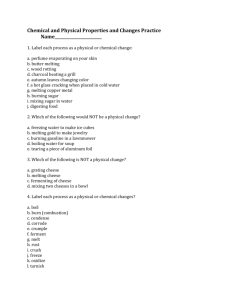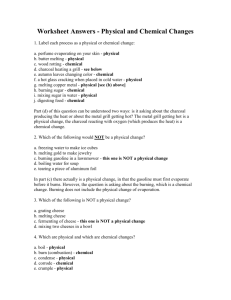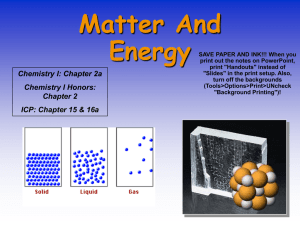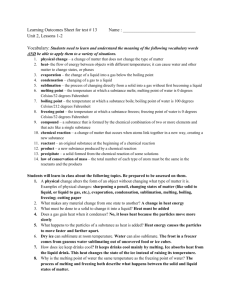Matter Properties - Killeen Independent School District
advertisement
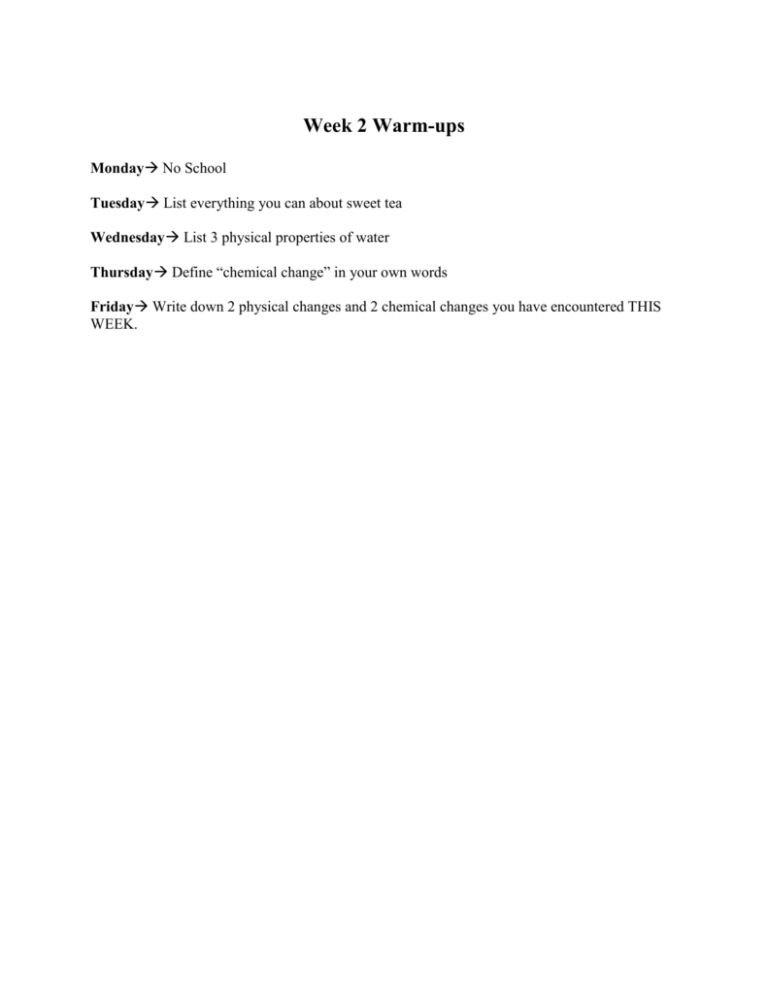
Week 2 Warm-ups Monday No School Tuesday List everything you can about sweet tea Wednesday List 3 physical properties of water Thursday Define “chemical change” in your own words Friday Write down 2 physical changes and 2 chemical changes you have encountered THIS WEEK. Unit 2 Lesson 1 Vocabulary Matter Anything that occupies space and has mass Physical property A property that a substance displays without changing its chemical composition Chemical property A property displayed by a substance only after undergoing a change in chemical composition Density The ratio of an object’s mass to its volume Mass A measure of the quantity of matter making up an object Weight A measure of the pull of gravity on an abject. Fluctuates with gravity change. Volume A measure of space. Any unit of length raised to the third power becomes a unit of volume Viscosity A measure of the resistance of a liquid to flow Reactivity The tendency of a substance to undergo chemical change, either by itself or in combination with other materials, and to release energy Extensive property A property that is dependent upon the amount of a given substance (Ex. Mass) Intensive property A property that is independent of the amount of a given substance Chemical change A change that alters the molecular composition of a substance Physical change A change that occurs without altering the molecular composition of a substance Phase change Change of matter from one phase to another induced by temperature, pressure, or both Chemical and Physical Properties Physical Properties Intensive Extensive Density Color Conductivity Malleability Luster Boiling Point Melting Point Freezing Point Phase Mass Weight Volume Chemical Properties Combustion Toxicity Flammability Oxidation/Reduction Acidic/Basic Reactivity Image: http://www.msm.cam.ac.uk/SeeK/graphics/popups/slg.gif 1. Atoms are vibrating 2. Does not take shape or size of container 1. Atoms move fluidly past each other 2. Takes shape but not size of container 1. Atoms move quickly and randomly 2. Takes both shape and size of container Less energy -------------------------------------------------------- More Energy More Dense ------------------------------------------------------- Less Dense More Structure -------------------------------------------------- Less Structure Atoms Less Mobile ----------------------------------------- Atoms More Mobile More Conductive --------------------------------------- Less Conductive Phase Changes Image: http://media.web.britannica.com/eb-media/40/149040-004-A417A659.jpg 1. Label each process as a physical or chemical change: a. Perfume evaporating on your skin b. Butter melting c. Wood rotting d. Charcoal heating a grill e. Autumn leaves changing color f. A hot glass cracking when placed in cold water g. Melting copper metal h. Burning sugar i. Mixing sugar in water j. Digesting food 2. Which of the following would NOT be a physical change? a. freezing water to make ice cubes b. melting gold to make jewelry c. burning gasoline in a lawnmower d. boiling water for soup e. tearing a piece of aluminum foil 3. Which of the following is NOT a physical change? a. grating cheese b. melting cheese c. fermenting of cheese d. mixing two cheeses in a bowl 4. Which are physical and which are chemical changes? a. boil b. burn (combustion) c. condense d. corrode e. crumple f. ferment g. melt h. rust i. crush j. freeze k. oxidize l. tarnish m. explode n. grind o. rot p. vaporize q. photosynthesis r. sublimation 5. If a certain mixture is homogeneous, you would properly conclude that the physical properties and the composition: a. are different from one part of the sample to another b. vary smoothly from top to bottom of the sample c. are the same in every small volume element from the sample d. none of these 6. Label each process as a physical or chemical change: a. Moth balls gradually vaporize in a closet b. hydrofluoric acid attacks glass (used to etch glassware) c. A chef making a sauce with brandy is able to burn off the alcohol from the brandy, leaving just the brandy flavoring d. Chlorine gas liquefies at -35 °C under normal pressure e. hydrogen burns in chlorine gas 7. Label each process as a physical or chemical change: a. fogging a mirror with your breath b. breaking a bone c. mending a broken bone d. burning paper e. slicing potatoes for fries f. mixing sugar with coffee g. frying chicken h. a nail rusting i. paper ripping j. wood burning k. mixing water and food coloring l. food molding (rotting) m. writing on paper n. dyeing fabric Write a paragraph describing the water cycle. It must be at least 5 sentences and include all the vocabulary words of the cycle (i.e. evaporation, melting, etc).
